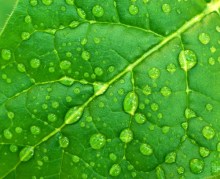First Practical Artificial Leaf Produces Hydrogen Fuel From Sunlight and Water

The artificial leaf is a pretty simple device, in theory. Ideally, you’d want it to behave mostly like a normal leaf, except instead of generating sugars through its process of photosynthesis, you’d want it to stop short at separating water into hydrogen and oxygen, using the hydrogen in a fuel cell and then getting electricity. In fact, previous versions of the artifical leaf were able to do just that. Drop them in some water and throw it in some sunlight and it would start bubbling up hydrogen. The problem was that these leaves relied on expensive metals like platinum and also required expensive production methods, making the tech too cost prohibitive to be particularly useful.
A new breakthrough published in Accounts of Chemical Research details a process by which the platinum catalyst that was previously required for the hydrogen producing cells can be replaced by a nickel-molybdenum-zinc compound which, despite the longer name, is actually cheaper to produce. Along with things like dirt batteries and devices that can generate electricity from boiling water, this new artificial leaf technology marks another advance in bringing electricity to third world countries, and perhaps even making electricity generation cleaner on the whole. There’s no telling when this tech will start making the rounds, but I’d sure like to see it in action; it sounds way cooler than salad.
(via Science Daily, image via Shutterstock)
Have a tip we should know? tips@themarysue.com